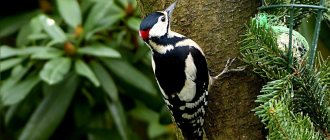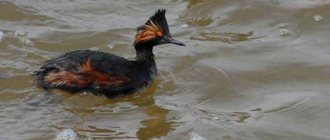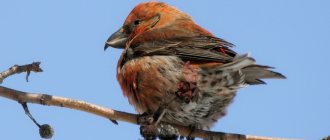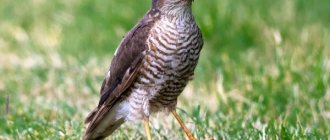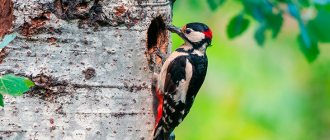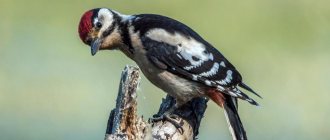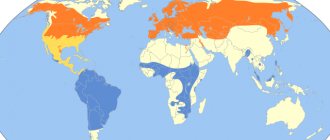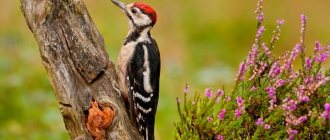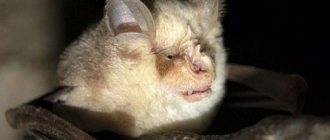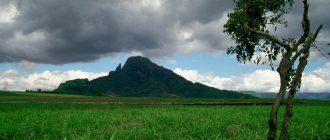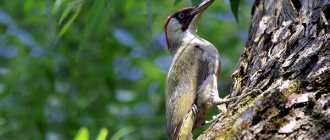13645
13646
13647
13648
13995
13996
13997
13998
Appearance and lifestyle
The gray woodpecker (Picus canus) is somewhat smaller than the green woodpecker, in comparison with which it appears more graceful. The length of its body reaches 25-28 cm, weight ranges from 90 to 70 g. The gray-haired woodpecker is characterized by a greenish-grayish coloration of the body, especially the back; its flight is undulating with alternating rises and glides. During the pre-nesting period this woodpecker is noisy, but during the nesting period it is silent and secretive. In autumn it becomes more noticeable again, possibly due to an increase in numbers due to nomadic individuals. In winter it is extremely silent and inconspicuous. At this time, he willingly visits hanging bird feeders; he can often be seen climbing the walls of various buildings, including brick ones. Sometimes found in garbage dumps and various garbage heaps.
It differs well from the green woodpecker, which is similar in general color, by its gray head and darker color on the underside of the body. A reliable distinguishing feature is the distribution of black and red areas of plumage on the head. If the green woodpecker (in males and females) has the entire top of its head red, then in the gray woodpecker only the males have a red spot on the forehead; The “whiskers” of the green woodpecker occupy the entire space from the corners of the beak to the eyes; in the gray woodpecker, only a thin dark strip extends down from the beak.
The head of an adult male is gray, there is a red spot on the forehead, which in some birds can occupy the entire front part of the head. On the feathers of the back of the crown, more or less pronounced blackish shafts are often visible. A black stripe runs from the base of the beak to the eye, and on the sides of the head there are black “whiskers” that reach the beak. The adult female is similar in plumage color to the male and differs from him in the absence of a red spot on the forehead. The plumage on the forehead has black longitudinal streaks.
In vocalization, these two species are very similar to each other, although with certain skills they are quite easily distinguished. The mating cry in both species is a trill, repeated with a certain periodicity. The gray woodpecker's trill is shorter and more melodic, while the green woodpecker's cry is “thick,” rich and hoarse.
Signs.
| gray woodpecker |
The hoary, or grey-headed, woodpecker is larger than the spotted woodpecker. The dorsal side is grayish-green, the loin is bright greenish-yellow. The underparts and head are mostly grey. The eyes are white, with a grayish-blue, reddish or pink tint. The male has a red cap, the female has only black streaks on the crown, no red, the green color on the back is duller. It can only be confused with the green woodpecker, from which it should be distinguished by the absence of a solid black “mask”, only the “whiskers” and a small stripe between the beak and eye are black. There are no red feathers on the whiskers; the red color on the male's cap only reaches the crown.
The young are generally colored like adults, the males already have a red cap, but the entire plumage is grayer, almost entirely with vague blackish ripples, the “whiskers” and frenulum are unclear, the eyes are reddish or reddish-brown. Weight 90-170 g, length 25-28, wing 14.3-15.1, span 38-42 cm.
Habitat
The natural range of the gray woodpecker covers a narrow strip of mixed and broad-leaved forests of Eurasia from France, Switzerland and Croatia east to Sakhalin and Hokkaido, as well as large parts of eastern and south-eastern Asia south to the Malay Peninsula and Sumatra. The northern edge of the range runs approximately along the border of the continuous taiga, while the southern edge runs through sections of the forest-steppe zone. When nesting, the gray-haired woodpecker adheres to deciduous and mixed forests with aspen, often settling near clearings, clearings, and lakes. In different parts of its range, its habitats are heterogeneous due to the nature of the growth of woody vegetation. In the Carpathians, it prefers beech forests, climbing through them into the mountains up to 1,200 m; in Latvia, small deciduous and mixed forests; it readily inhabits old parks and cemeteries; In Belovezhskaya Pushcha, nesting stations are old broad-leaved and pine-oak-hornbeam stands.
Links[edit]
- ^ B s d e e BirdLife International (2016). " Picus canus
".
IUCN Red List of Threatened Species
.
2016
: e.T22726503A86924320. DOI: 10.2305/IUCN.UK.2016-3.RLTS.T22726503A86924320.en.CS1 maint: uses the authors parameter (link) - ↑
Linnaeus (1788–1793). Ya. F. Gmelin (ed.). Systema Naturae. t. 1 pt. 1 (13th ed.). Lipsiae. item 434. - Datenblatt IUCN
- Gmelin, Johann Friedrich (1788). Systema naturae per regna tria naturae: classes secundum, ordines, genera, species, cum characteribus, differentials, synonyms, locis (in Latin). Volume 1, part 1 (13th ed.). Lipsiae [Leipzig]: Georg. Emanuel. Beer. pp. 434–435.
- Peters, James Lee, ed. (1948). Checklist of Birds of the World. Volume 6. Cambridge, MA: Harvard University Press. paragraph 135.
- Jobling, James A. (2010). Helm's Dictionary of Scientific Names for Birds. London: Christopher Helm. paragraph 89. ISBN 978-1-4081-2501-4.
- Gill, Frank; Donsker, David; Rasmussen, Pamela, ed. (2020). "Woodpeckers". IOC World Bird List, version 10.1
. International Union of Ornithologists. Retrieved May 28, 2022. - "Black woodpecker Picus guerini". IUCN Red List of Threatened Species
. Retrieved June 2, 2022 .URL of old form - "Sumatran woodpecker Picus dedemi". IUCN Red List of Threatened Species
. Retrieved June 2, 2022 .URL of old form - Eugene M. McCarthy: A Guide to the Avian Hybrids of the World
. Oxford University Press, 2006. ISBN 978-0-19-518323-8, S. 109. - Gorman (2004), p. 59.
- Cramp 1985, pp. 813, 823.
- Cramp 1985, pp. 813-814.
- Jump up
↑ Short 1982, p. 488. - Jump up
↑ Winkler, H. & Christie, D. A. (2016). Gray woodpecker (Picus canus). In: del Hoyo, J., Elliott, A., Sargatal, J., Christie, D. A. & de Juana, E. (eds.). Directory of living birds of the world. Lynx Editions, Barcelona. (Retrieved from https://www.hbw.com/node/56316 on October 5, 2016). - ^ abc Gorman, Gerard (2014). Woodpeckers of the World: A Photographic Guide
. Firefly Books. pp. 453–455. ISBN 978-1770853096. - ^ ab Niethammer, G., Rheinwald, G. & Wolters, H. E. 1983. Zauber und Schönheit unserer Vogelwelt.
Verlag Das Beste, Stuttgart, Germany, p. 53. ISBN 387070201X - ^ ab Nicholas, J. 1982. Fotoatlas der Vögel.
Gräfe und Unzer, Munich, Germany, p. 241. ISBN 3-7742-3813-8 - ↑ Handbuch der Vögel Mitteleuropas
, 1994, Vol. 9, pp. 921ff - Gorman (2004), p. 60
- Gorman (2004), S. 61f.
- ↑
Bauer / Berthold (1997), S. 283. - Birdlife International newsletter (2006).
- Birdlife Europe Newsletter (2004).
- Gorman, Gerard (2004): Woodpeckers of Europe: a study of the European Picidae. Bruce Coleman, UK. ISBN 1-872842-05-4.
Nutrition
The diet of the gray woodpecker is somewhat more varied than that of the green woodpecker. It is also based on ants and termites, but in addition, the gray woodpecker feeds on other insects (beetle larvae, caterpillars, crickets) and spiders. In autumn and winter, gray woodpeckers eat plant foods - the fruits of some fruit trees (apple trees, pears, cherries), seeds, berries, nuts, acorns. During the cold season, it often visits feeders.
Typically, the gray-haired woodpecker feeds on the surface of the ground, jumping from place to place: it probes the soil with its beak, plunges it into underground ant passages and captures prey with its sticky tongue. Sometimes, more often in winter, it obtains food from the trunks of diseased trees, similarly searching ant passages. It hammers relatively little and mostly soft material like pieces of rotten bark.
Sources [edit]
- Cramp, Stanley, ed. (1985). " Picus canus
Grey-headed Woodpecker."
Handbook of Birds of Europe, the Middle East and North Africa.
Birds of the Western Palaearctic . Volume IV: Terns to Woodpeckers. Oxford: Oxford University Press. pp. 813–824. ISBN 978-0-19-857507-8. - Short, Lester L. (1982). "Grey Woodpecker". Woodpeckers of the world
. Monograph Series 4. Greenville, DE: Delaware Museum of Natural History. pp. 483–488. ISBN 0-913176-05-2.
Reproduction
The gray-haired woodpecker breeding at the end of the first year of life. The first mating calls of a male in central Europe during mild winters can be heard as early as the end of January, although they reach their apogee in the second half of February and early March. The active current continues until the end of April, sometimes until the beginning of May. Before a pair forms, woodpeckers behave very mobile, moving from one area to another. This is due to the relative rarity of the species - having chosen a site, the male often leaves it if the female does not respond to his cry. On the contrary, as soon as a pair is formed, the birds stop wandering and stick to the finally chosen territory. The singing male usually sits on the upper dry branches of some large tree, most often he can be heard between 8 and 10 o'clock in the morning. In addition to singing, he sometimes makes short drum beats. During courtship, the bird lands near its partner or the chosen nest site with a loud flapping of its wings. Sometimes the male ritually feeds the female.
The nest is made in a hollow at a height of 0.2-24 m (usually 1.5-8) from the ground surface. Typically, gray woodpeckers choose deciduous trees with soft wood - maple, aspen, alder, birch, etc., sometimes dead or damaged by fungus. Construction takes from 9 to 20 days; the male and female hollow out the hollow. The entrance has the shape of a vertically elongated oval; The depth of the hollow is 25-30 cm, the diameter of the hollow is 15-20 cm, the diameter of the hole is about 6 cm. There is no additional lining, but at the bottom of the nest there is always a layer of crushed rotten wood. The clutch size varies depending on the habitat - in the Himalayas it is 4-5 eggs, in central Europe 7-9. Both members of the pair incubate the eggs, with the male sitting at night and most of the day. During this period, the birds are silent and behave secretly. Chicks are born 14-17 days after the last egg is laid. Both parents feed the offspring by regurgitating food from beak to beak. Sometimes another female brings food to the nest. After 23-27 days, the grown chicks rise to the wing, but even before mid-summer they wander with their parents, after which they disperse.
Gray woodpecker in the Red Book
This species is included in the Red Book of Lithuania and is protected in several regions of the Russian Federation. Due to a sharp reduction in the number of individuals in the Carpathians, the gray green woodpecker was listed in the Red Book of Ukraine.
Main causes of extinction
There are three main reasons for the population decline. The first is associated with the reduction of dead and rotting trees as a result of sanitary felling. The second reason is the disappearance of forest red ants from urban forests.
Also responsible for the threat of bird extinction is the replacement of the natural woody environment in river valleys with grassy parklands.
That is why the gray-headed woodpecker is a species that has disappeared in Moscow and the Moscow region. However, the possibility of recovery in the future is not completely lost.
Current population situation
Since 1990, there has been a gradual recovery of the population in the European part due to mild winters. There are currently between 180,000 and 320,000 breeding pairs living in this area. However, on a global scale, the decline in numbers continues.
Do you need to take protective measures?
To preserve the population, it is necessary to apply restrictive measures. Therefore, when paired individuals are detected, a land plot is allocated with restrictions on recreational use.
When renewing forest belts, it is necessary to leave areas with perennial specimens with rotten filling. This is an effective measure to provide birds with a habitat.
Ivanovo region
Status: III category. Rare view.
Spreading
On the territory of the Ivanovo region, most sightings are observed outside the nesting period - in early spring and autumn, and occasionally in winter. During nesting time it was observed in the environs. Ivanova, near the village. Krasnogorsky, in the Klyazminsky reserve, the Balakhninskaya lowland, the vicinity of the lake. Rubsky, Yurtsino, in the valley of the river. Wow, Tezy.
Number
The number in the Ivanovo region is unknown.
Source: Red Book of Ivanovo Region. Volume 1. Animals. Ed. Isaev V.A., Egorov S.V., Tikhomirov A.M., Barinov S.N., Lazareva O.G. (2007) Ivanovo: IPK “PresSto”
Where do they live?
In Africa, woodpeckers are common in Algeria and Tunisia, Morocco and the Canary Islands of Tenerife and Gran Canaria.
In Europe they live almost everywhere, except for Ireland, Scandinavia and the Russian Arctic. In the Balkans and Asia Minor they are found in the mountains. A large population lives in the Caucasus, Transcaucasia and northern Iran in areas near the Caspian Sea.
The habitats of woodpeckers are very diverse: from the northern taiga to forest plantations, gardens and parks. Birds nest up to the upper border of the forest: on average up to 2000 m above sea level. In all regions of their habitat, woodpeckers are sedentary birds, and migrate only in case of food shortage.
Subspecies[edit | edit code]
The Guide to the Birds of the World lists 11 subspecies of the gray woodpecker, distributed from western Europe to Southeast Asia[9]. The background and details of the color vary greatly depending on the area of residence: in palearctic forms the difference is expressed in the intensity of green shades and in the degree of development of gray; in tropical populations the color is more varied and may include an additional range of colors and details of the pattern [10]. For example, the dedemi subspecies living in Sumatra has a rich crimson color throughout its body[4]. The Indo-Malayan subspecies are sometimes classified as a separate species, Picus guerini[4].
- Picus canus canus JF Gmelin, 1788 - Eurasia from southern Scandinavia and France east to Western Siberia
- Picus canus jessoensis Stejneger, 1886 - Eastern Siberia, Sakhalin, Hokkaido, China from northeastern to southern provinces, Korean Peninsula.
- Picus canus sanguiniceps Stuart Baker, 1926 - northeastern Pakistan, northern India, western tip of Nepal
- Picus canus hessei Gyldenstolpe, 1916 - Nepal east to Myanmar, extreme southern China (southern Yunnan), most of Thailand and Vietnam
- Picus canus guerini (Malherbe, 1849) - from northern China south to central Sichuan
- Picus canus kogo (Bianchi, 1906) - central China from Qinghai province east to Shanxi, south to Sichuan
- Picus canus sordidior (Rippon, 1906) - Southeast Tibet east to western Sichuan, south to Yunnan and northeastern Myanmar
- Picus canus sobrinus JL Peters, 1948 - northeastern Vietnam, southeastern China (from Guangxi east to Fujian)
- Picus canus tancolo (Gould, 1863) - Taiwan, Hainan
- Picus canus robinsoni (Ogilvie-Grant, 1906) - mountainous regions of the central part of the Malay Peninsula (Gunung Tahan, Cameron Highlands)
- Picus canus dedemi (van Oort, 1911) - highlands of Sumatra
Notes[edit | edit code]
- ↑ Boehme R.L., Flint V.E. Five-language dictionary of animal names. Birds. Latin, Russian, English, German, French / Under general. ed. acad. V. E. Sokolova. - M.: Russian language, RUSSO, 1994. - P. 202. - 2030 copies. — ISBN 5-200-00643-0.
- ↑ Ivanov et al., 1953, p. 313.
- ↑ Grey-headed woodpecker (Picus canus) Gmelin, 1788. Avibase. Access date: September 30, 2013.
- ↑ 1 2 3 Picus canus Gmelin, 1788 - Gray-haired woodpecker. Vertebrates of Russia. Severtsov Institute. Access date: May 3, 2010.
- ↑ Malchevsky, Pukinsky, 1983, p. 278.
- ↑ 1 2 3 4 Ryabitsev, 2001, p. 341.
- ↑ 1 2 3 Mullarney et al., 2000, p. 224.
- ↑ 1 2 Malchevsky, Pukinsky, 1983, p. 279.
- ↑ 1 2 3 4 5 6 7 8 9 10 11 Winkler, Christie, 2006, p. 543.
- ↑ 1 2 3 Stepanyan, 2003, p. 307.
- ↑ Cramp, Simmons, 1986, p. 814.
- ↑ Gray woodpecker Picus canus Gmelin, 1788. Birds of Central Siberia. birds.krasu.ru. Access date: May 18, 2010.
- ↑ 1 2 Gorman, 2004, p. 57-68.
- ↑ Malchevsky, Pukinsky, 1983, p. 278-279.
INTERESTING FACTS
Most woodpeckers, of which there are more than 200 species in the world, live in hollows. They are usually hollowed out in softwood trees. In deserts, birds use large cacti instead, and earthen cacti dig holes in the ground. But there are also absolutely amazing woodpeckers - red-headed woodpeckers. They live in the nests of fire ants - aggressive, dangerous, numerous insects from which the largest animals flee! Woodpeckers make a hole in a strong anthill, the female lays eggs there and calmly incubates. At the same time, she doesn’t even need to fly away to feed: the food crawls right there. Why ants never drive woodpeckers away is one of nature’s mysteries.
Novgorod region
Status: III category. A rare species that is in a state close to endangered.
Spreading
Distributed unevenly, with localization in the southern and eastern regions of the region. The most numerous encounters are in the Valdai region, in the complex forests of the floodplains of the Lovat and Kunya rivers in the Kholm and Poddor regions. In the Kholmsky district (including the city of Kholm) broods were noted. Nesting is likely in the Novgorod region. During the nesting period, the species was also recorded in the Moshensky and Soletsky regions. Modern meetings in the autumn-winter period are known in the Novgorod, Batetsky, Malovishersky, Lyubytinsky, Borovichsky, Valdai, Bolotovsky, Poddorsky and Kholmsky regions.
Number
The species has long been rare throughout the North-West. At the end of the 19th century. was common in the Kholmsky region and not numerous in the Moshensky region. Only one meeting was noted for Priilmenye. The current abundance of the species and its dynamics are unknown.
Source: Red Book of the Novgorod Region. Ed. Yu.E. Vetkin, D.V. Geltman, E.M. Litvinova, G.Yu. Konechnaya, A.L. Mishchenko (2015) St. Petersburg, Deaton publishing house
Conservation status by region:
- Vladimir region
- Ivanovo region
- Kostroma region
- Kursk region
- Leningrad region
- Lipetsk region
- Moscow
- Moscow region
- Nizhny Novgorod Region
- Novgorod region
- Oryol Region
- Penza region
- Republic of Tatarstan
- Saint Petersburg
- Sverdlovsk region
- Smolensk region
- Tver region
- Tula region
- Yaroslavl region
